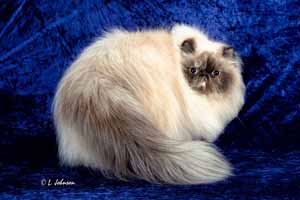


Photo courtesy of Larry Johnson Photography.
The Persian is often referred to as the classic long-haired cat. Its coat is layered, with short, coarse hair overlaying a long, luxuriously soft undercoat. Gentle and quiet, Persians are not usually playful companions, but they are undisturbed by children (and almost everything else). Nearly three-quarters of all registered pedigreed cats are Persian.
Breed-related concerns
Every cat breed carries a distinct set of genetic advantages and health risk factors. The following are the most common diseases found in the Persian breed. Hopefully, your Persian will not face these problems. However, early detection and preventive healthcare can make all the difference in helping your cat live a longer, happier life (see breed-related disease descriptions below).
Kitten (birth to 1 year)
Adult (1 to 6 years)
Senior (7 years and older)
Breed-related disease descriptions
Listed in alphabetical order
Corneal sequestrum. Black discoloration within the cornea (the clear window of the front of the eye). Clinical signs include black discoloration to the cornea and signs of eye pain (squinting, keeping the eye closed, keeping the third eyelid over the eye or excessive tearing).
Dermatophytosis (ringworm).
A fungus infection of the skin and hair. Signs may include hair loss, dandruff, skin crusts and sometimes small red bumps on the skin.
Polycystic kidney disease.
Damage to the kidneys, which may be inherited or result from infections, kidney stones, toxin exposure, autoimmune disease (where the body’s defense system attacks its own kidneys) or cancer. In many cases, the cause of kidney disease cannot be identified. Pets may show no signs until kidney disease is advanced. Signs may include increased drinking and urinating, urinating during the night, urinating outside of the litter box, decreased appetite, vomiting, diarrhea, weight loss, lethargy and sometimes blindness or convulsions.
Stenotic nares.
Narrowing and sometimes complete obstruction of the nostrils. Signs include noisy and difficult breathing and exercise intolerance.
Tear staining.
Wetness and discoloration of facial hair from tear overflow (epiphora). Most commonly seen in the corner of the eye near the nose.
Help your cat live a longer, healthier life. Ask your veterinarian about a breed-related preventive health plan.